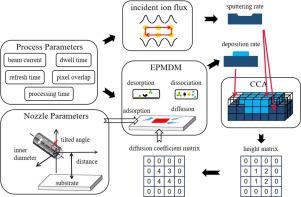Sensors and Actuators A: Physical ( IF 4.1 ) Pub Date : 2020-06-14 , DOI: 10.1016/j.sna.2020.112150 Chen Fang , Yan Xing , Zaifa Zhou , Qing Chai , Qianhuang Chen

|
Focused ion beam induced deposition (FIBID) is a high-resolution micro/nano fabrication technique with the injection of precursor gas to produce complex three-dimensional structures, which can be used to construct nanodevices. Due to the complex interaction between precursor gas, incident ions, and the substrate, the morphology of deposition structure dramatically depends on the process parameters. In this paper, based on the Continuous Cellular Automata (CCA) and the extended precursor molecule diffusion model (EPMDM), the effects of different process parameters on the final deposition morphology, are systematically studied. The experimental and theoretical work explores the relationship between the characterization of the deposition structure and process parameters. Considering the variation of diffusion effect intensity, the diffusion coefficient matrix decaying with the structure height is established to calculate the contribution of diffusion effect more precisely, which can also explain the non-uniform growth of deposition structure in the FIBID process. The vacuum surface cells (VSCs) and solid surface cells (SSCs) are recognized for deposition and sputtering respectively in the CCA, so as to trace the dynamic deposition contour, and reproduce the coexistence of deposition and sputtering phenomena. In order to verify the proposed CCA simulation model, micro pillar array and other structures are fabricated by focused Ga ion beam induced C9H16Pt precursor gas. The experimental and simulation results show that the proposed model can well simulate the morphology of deposition structures under a wide range of process parameters of dwell time, refresh time, ion beam current and pixel overlap. Therefore, the model can provide a good prediction method for parameter optimization of focused Ga ion beam induced deposition process.
中文翻译:

聚焦Ga离子束诱导沉积过程对微结构的结构表征和连续细胞自动机模拟
聚焦离子束诱导沉积(FIBID)是一种高分辨率的微/纳米制造技术,可注入前驱气体以产生复杂的三维结构,可用于构造纳米器件。由于前驱气体,入射离子和基板之间的复杂相互作用,沉积结构的形态极大地取决于工艺参数。本文基于连续细胞自动机(CCA)和扩展前体分子扩散模型(EPMDM),系统地研究了不同工艺参数对最终沉积形态的影响。实验和理论工作探索了沉积结构的表征与工艺参数之间的关系。考虑到扩散效应强度的变化,建立了随结构高度衰减的扩散系数矩阵,可以更精确地计算扩散效应的贡献,这也可以解释FIBID过程中沉积结构的不均匀生长。在CCA中分别识别出真空表面单元(VSC)和固体表面单元(SSC)用于沉积和溅射,以追踪动态沉积轮廓,并再现沉积和溅射现象的共存。为了验证所提出的CCA仿真模型,通过聚焦Ga离子束诱导的C制造了微柱阵列和其他结构。在CCA中分别识别出真空表面单元(VSC)和固体表面单元(SSC)用于沉积和溅射,以追踪动态沉积轮廓,并再现沉积和溅射现象的共存。为了验证所提出的CCA仿真模型,通过聚焦Ga离子束诱导的C制造了微柱阵列和其他结构。在CCA中分别识别出真空表面单元(VSC)和固体表面单元(SSC)用于沉积和溅射,以追踪动态沉积轮廓,并再现沉积和溅射现象的共存。为了验证所提出的CCA仿真模型,通过聚焦Ga离子束诱导的C制造了微柱阵列和其他结构。9 H 16 Pt前驱气体。实验和仿真结果表明,该模型可以很好地模拟沉积时间,刷新时间,离子束电流和像素重叠等一系列工艺参数下的沉积结构形态。因此,该模型可以为聚焦Ga离子束诱导沉积工艺的参数优化提供良好的预测方法。











































 京公网安备 11010802027423号
京公网安备 11010802027423号